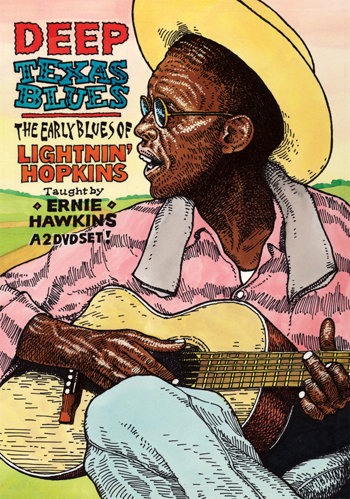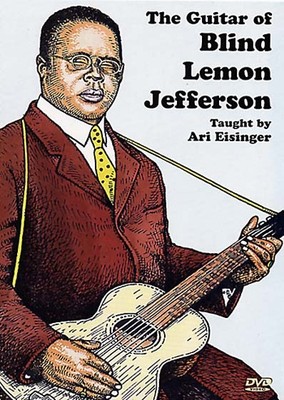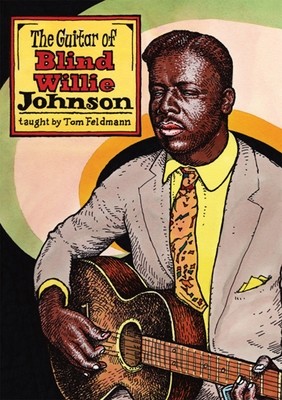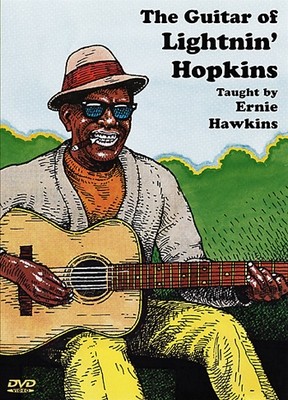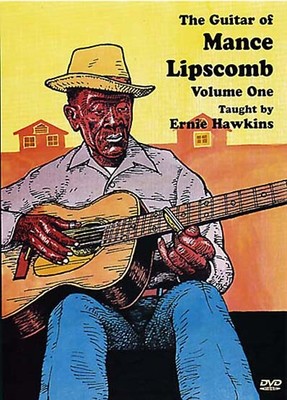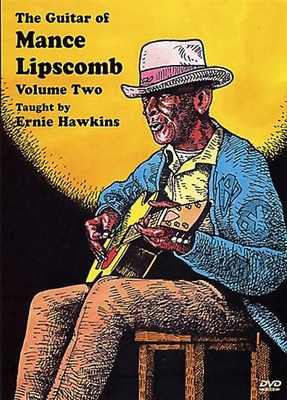
Deep Texas Blues: The Early Blues of Lightnin' Hopkins (2 DVD Set) - taught by Ernie Hawkins
In this second DVD lesson devoted to the guitar playing of Lightnin' Hopkins, Ernie Hawkins dives into Lightnin's early catalogue from the Aladdin and Gold Star record labels. There was an amazing variety to Lightnin's early work. Listening to his early recordings we hear an artist at his prime. He effortlessly employing widely different rhythms, keys and tunings. The deeper we listen to these songs, the deeper our insight into what a master of Texas blues Lightnin' Hopkins really was.
Lightnin's style itself came along at the perfect time: the advent of the electric guitar. His style, strong rhythms punctuated by his flowing but compact lead lines created a stinging and heart-tearing evocative sound. Lightnin's guitar style and technique worked great for both the acoustic or electrical guitars. The blues of Freddy King, Albert Collins, the Vaughn brothers, Billy Gibbons, testify to the power of this style. Lightnin' connects the generations of players, starting with Blind Lemon Jefferson, for whom he was lead-boy in the early 1920s. Standing tall at the center of the Texas Blues story is Lightnin' Hopkins.
In this double DVD set, Ernie Hawkins covers songs in unusual keys such as: drop D (Sugar Mama), in drop D but played in the key of A (Santa Fe Blues), in G (Bad Luck and Trouble), as well as in the usual blues in A, Come Back Baby and the country gospel Needed Time in the key of E. As a bonus, Ernie teaches his version of Lightnin's Hideway, the Freddy King tune coming back home to Lightnin'.
Ernie teaches phrase by phrase and then uses the split-screen so you can carefully study what each hand is doing. Detailed tab/music booklets are included as PDF files on both DVDs.
186 minutes • Level 2/3 • Detailed tab/music PDF files on the DVDs
Review: Few players have steeped themselves in the styles of the great blues masters like Ernie Hawkins. Having lived with and studied the playing of the Reverend Gary Davis right out of high school, Hawkins is one of the U.S.'s leading practitioners of Davis's much-emulated style. He has also put out DVD's on Mance Lipscomb and Blind Willie McTell. And Davis has also plumbed the depths of another great blues player, Lightnin' Hopkins, on "Deep Texas Blues." This 2-DVD set is a follow-up to his first volume on the style of Hopkins. Like all of the teaching DVD's produced by Stefan Grossman's Guitar Workshop, the audio fidelity is excellent, and the DVD's give enough close up and split-screen views to give the learner lots of chances to see just how Hawkins manages to play in Hopkins' style. Going green, the DVD's have pdf files with tab/music booklets for adding learning. Hawkins is a warm and gracious teacher, and clearly walks the learned through the five songs studied on these two DVD's. He brings out many of the peculiar elements of Hopkins' songs. For example, he shows how Hopkins varies the use of bass in his songs depending on the tune. On "Come Back Baby," Hawkins shows how an initial run leads right into the bass note, and gives all kinds of variations on the scale shapes Hopkins uses. Like many blues players, Hopkins played the melody as he sang over it. Hawkins also shows how Hopkins most likely set the stage for many great electric blues players with his style (Hopkins played both acoustic and electric blues). Each DVD is filled with bonus files. The first has 3 audio files and 2 videos of Hopkins playing, while the second has 12 audio files and 2 more videos. If you love the blues and want to learn the power of Lightnin' Hopkins and his Texas blues, there is no better place to start than this set. – © Kirk Albrecht, minor7th.com
Review: To play Lightnin' Hopkins on guitar is to harness the gut bucket greatness of blue Texas. The components of his sidewalk shuffles and beer hall boogies became the raw ingredients which fellow statesmen like Freddie King and those Vaughan Brothers ultimately baked into high-voltage, rock-leaning attacks. But for patrons inside ghetto joints around Houston's Third Ward, the signature stew of lowdown licks quick-draw runs, and tensioned triplets that Hopkins hustled was all the heaven they needed. Part hero worship, part-library, (biggest) part how-to instructional, The Early Blues of Lightnin' Hopkins picks apart two DVDs worth of his 1940's Aladdin and Gold Star sides. Returning to teach this sequel lesson to The Guitar Of Lightnin' Hopkins is Ernie Hawkins, who, didn't get to play alongside the man, but did with Texan Mance Lipscomb, as well as Son House, Fred McDowell, and Rev. Gary Davis. Among his detailed dissections here are "Sugar Mama" and the sweet gospel of "Needed Time." An embedded bonus is a mini-stockpile of Hopkins' original recordings, as well as a handful of filmed performances, including a solo "Bunion Soup" and a band-aided "Ain't No Cadillac." By laying out the blueprints to such devastators as "Lonesome Road" and "Bad Luck And Trouble," suspicions are confirmed that Lightnin' Hopkins was one bad hombre, starting with that bad ass D-minor run. – Dennis Rozanski/BluesRag
Review: Lightning Hopkins was one of the first of the "rediscovered" bluesmen, found and recorded for Folkways label in 1959 by Sam Charters. Hopkins had been recording singles for several black labels, had a few minor hits, then sank into obscurity, playing local clubs in Houston. After his first LP was released he went on to have several years on the college and club circuit, playing for rapt white youth there, and even scored a chart hit with "Mojo Hand." This double DVD set focuses on his earlier 78 recordings for Aladdin and Gold Star Labels. Tutor Ernie Hawkins is an apt student and teacher, he simplifies and passes on many of Lightning's characteristic riffs and tricks, such as his use of unison guitar vocal lines-where he plays the same melody line he's singing. The seven tunes covered get pretty thorough workups, the whole set runs for 3:06. Titles include his only recorded gospel number Needed Time as well as Santa Fe Blues. Besides the 7 song lessons there are a couple of tunes performed by Lightning himself, shot in 1960 Bunion Stew and Baby Come Go Home With Me. The discs also have PDF files with guitar tab and lyrics for all the songs included. Bonus tracks are audio files of several old recordings, including the original versions of tunes used here. – Tony Glover
